G.Skill Phoenix Blade (480GB) PCIe SSD Review
by Kristian Vättö on December 12, 2014 9:02 AM ESTRandom Read/Write Speed
The four corners of SSD performance are as follows: random read, random write, sequential read and sequential write speed. Random accesses are generally small in size, while sequential accesses tend to be larger and thus we have the four Iometer tests we use in all of our reviews.
Our first test writes 4KB in a completely random pattern over an 8GB space of the drive to simulate the sort of random access that you'd see on an OS drive (even this is more stressful than a normal desktop user would see). We perform three concurrent IOs and run the test for 3 minutes. The results reported are in average MB/s over the entire time.
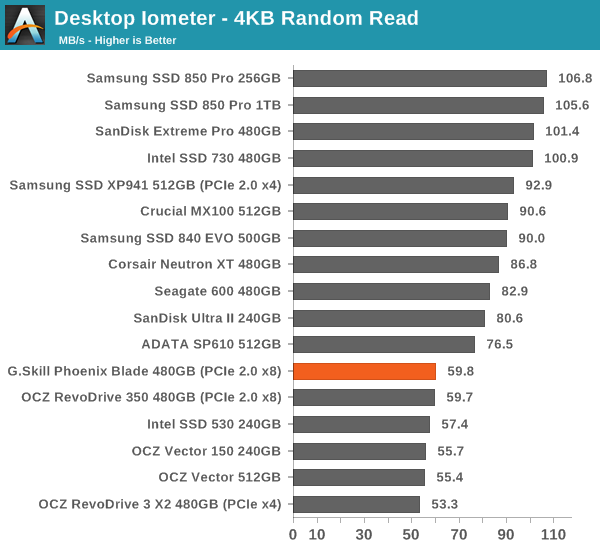
Random read speed is typical SandForce, which makes sense because the performance doesn't scale across multiple controllers at such low queue depths (QD=3 in this case).
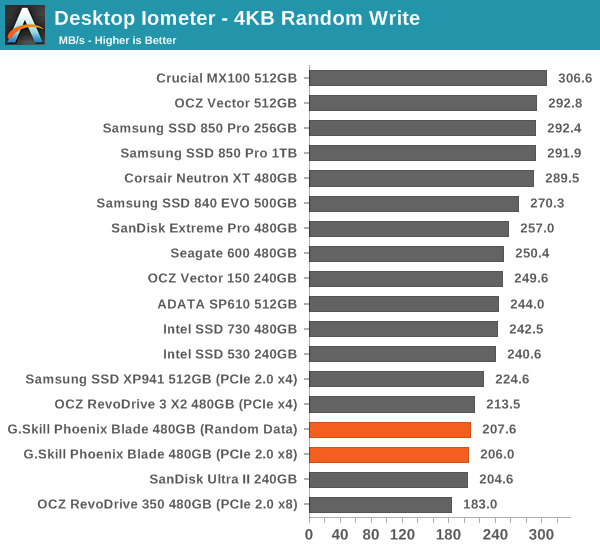
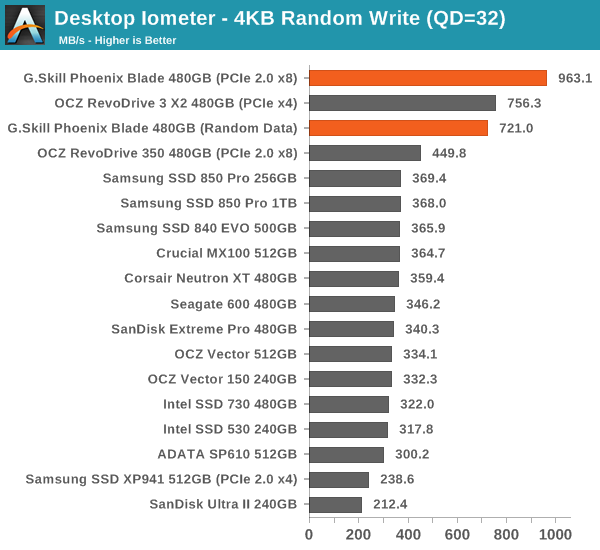
The same goes for random write performance at queue depth of 3, which isn't very high but is normal for SandForce based drives. However, the Phoenix Blade scales brilliantly with the queue depth and is considerably faster than the XP941 or RevoDrive 350.
Sequential Read/Write Speed
To measure sequential performance we run a 1 minute long 128KB sequential test over the entire span of the drive at a queue depth of 1. The results reported are in average MB/s over the entire test length.

Sequential performance is also excellent, although the XP941 enjoys a slight advantage in sequential read performance. Overall the Phoenix Blade seems to be well optimized for parallelism -- much better than the RevoDrive 350 -- as it's able to provide substantially higher performance than SATA drives.
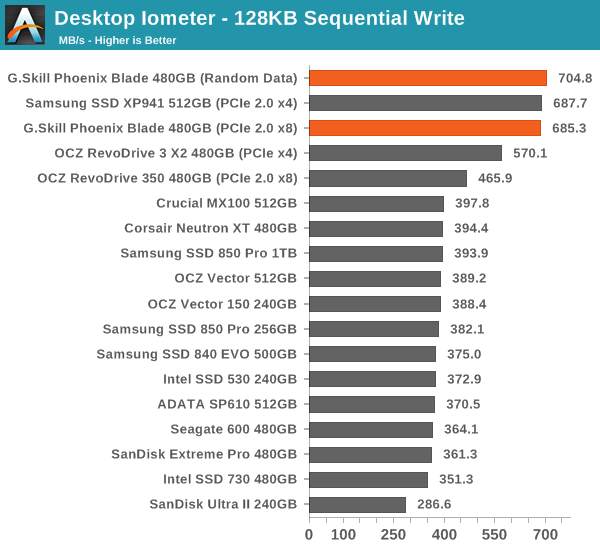
AS-SSD Incompressible Sequential Read/Write Performance
The AS-SSD sequential benchmark uses incompressible data for all of its transfers. The result is a pretty big reduction in sequential write speed on SandForce based controllers, but most other controllers are unaffected.
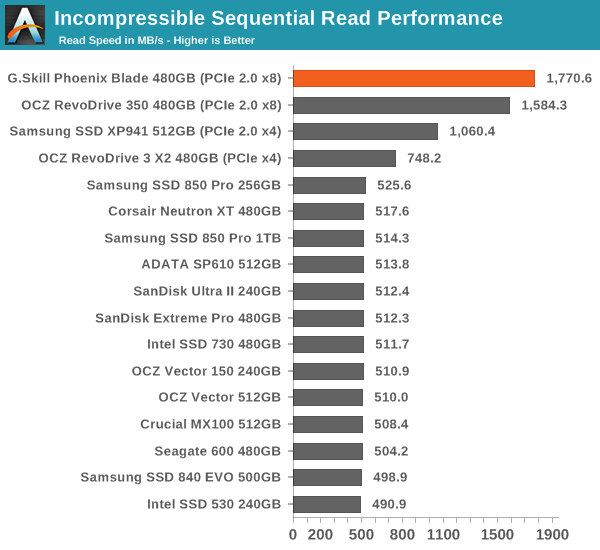
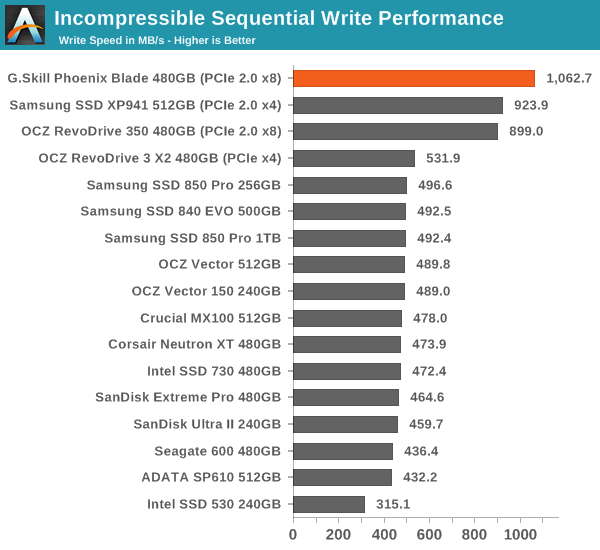










62 Comments
View All Comments
Duncan Macdonald - Friday, December 12, 2014 - link
How does this compare to 4 240GB Sandforce SSDs in software RAID 0 using the Intel chipset SATA interfaces?Kristian Vättö - Friday, December 12, 2014 - link
Intel chipset RAID tends not to scale that well with more than two drives. I have to admit that I haven't tested four drives (or any RAID 0 in a while) to fully determine the performance gains, but it's safe to say that the Phoenix Blade is better than any Intel RAID solution since it's more optimized (specific hardware and custom firmware).nathanddrews - Friday, December 12, 2014 - link
Sounds like you just set yourself up for a Capsule Review.Havor - Saturday, December 13, 2014 - link
I dont get the high praise of this drive, sure it has value for people that need high sequential speed, or people that use it to host a database on a budget that have tons of request, and can utilize high QD, all other are better off with a SATA SSD that preforms much better with a QD of 2 or less.As desktop users almost never go over QD2 in real word use, so they would be much better of with a 8x0 EVO or so, both performance wise as price wise.
I am actually wane of the few that could use the drive, if i had space for it (running quad SLI), as i use a RAMdrive, and copy programs and games that are stored on the SSD in a RAR file, true a script from a R0 set of SSDs to the RAMdisk, so high sequential speed is king for me.
But i count my self in the 0.1% of nerds, that dose things like that because i like doing stuff like that, any other sane person would just use a SSD to run its programs of.
Integr8d - Sunday, December 14, 2014 - link
The typical self-centered response: "This product doesn't apply to me. So I don't understand why anyone else likes it or why it should be reviewed," followed by, "Not that my system specs have ANYTHING to do with this, but here they are... 16 video cards, raid-0 with 16 ssd's, 64TB ram, blah blah blah..." They literally just look for an excuse to brag...It's like someone typing a response to a review of Crest toothpaste. "I don't really know anything about that toothpaste. But I saw some, the other day, when I went to the store in my 2014 Dodge Charger quad-Hemi supercharged with Borla exhaust, 20" BBS with racing slicks, HID headlights, custom sound system, swimming pool in the trunk and with wings on the side so I can fly around.
It's comical.
dennphill - Monday, December 15, 2014 - link
Thanks, Integ8d, you put a smile on my face this morning! My feelings exactly.pandemonium - Tuesday, December 16, 2014 - link
Hah. Nicely done, Integr8d.alacard - Friday, December 12, 2014 - link
The DMI interface between the chipset and the processor maxes out at about 1800~1850MB/s and this bandwidth has to be split between all the devices connected to the PCH which also incorporates an 8x pci 2.0 link. Simply put, there's not enough bandwidth to go around with more than two drives attached to the chipset in raid, not to mention that the scaling beyond 2 drives is fairly bad in general through the PCH even when nothing else is going on. And to top it all off 4k performance is usually slightly slower in Raid than a on a single SSD (ie it doesn't scale at all).I know Tomshardware had an article or two on this subject if you want to google it.
personne - Friday, December 12, 2014 - link
It takes three SSDs to saturate DMI. And 4k writes are nearly double on long queue depths. So you get more capacity, higher cost, and much of the performance benefit for many operations. Certainly tons more than a single SSD at a linear cost. If you research your statements.alacard - Friday, December 12, 2014 - link
To your first point about saturating DMI, we're in agreement. Reread what i said.To your second point about 4k, you are correct but i've personally had three separate sets of RAID 0 on my performance machine (2 vertex 3s, 2 vertex 4s, 2 vectors), and i can tell you that those higher 4k results were not impactful in any way when compared to a single SSD. (Programs didn't load faster for instance.)
http://www.tomshardware.com/reviews/ssd-raid-bench...
That leaves me curious as to what you're doing that allows you to get the benefits of high queue depth RAID0? What's your setup, what programs do you run? I ask because for me it turned out not to be worth the bother, and this is coming from someone who badly wanted it to be. In the end the higher low queue depth 4k of 1 SSD was a better option for me so i switched back.
http://www.hardwaresecrets.com/article/Some-though...